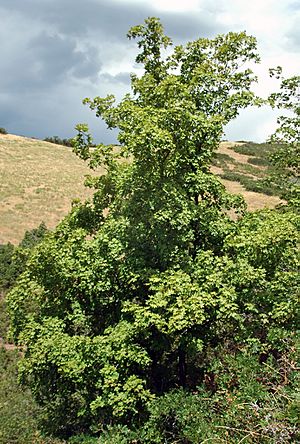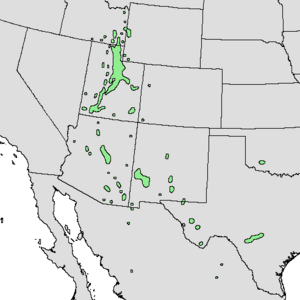Bigtooth maple facts for kids
Quick facts for kids Acer grandidentatum |
|
|---|---|
 |
|
| Bigtooth maple, Wasatch Mountains, Utah | |
| Conservation status | |
| Scientific classification | |
| Genus: |
Acer
|
| Species: |
grandidentatum
|
 |
|
| Generalized natural range | |
The bigtooth maple (its scientific name is Acer grandidentatum) is a type of maple tree. It grows naturally in the western parts of North America. You can find it in different places, from western Montana to central Texas in the United States. It also grows south into Coahuila, which is in northern Mexico.
Contents
What Does It Look Like?
The bigtooth maple is a small to medium-sized deciduous tree. This means it loses its leaves every fall. It can grow to be about 10 to 15 meters (33 to 49 feet) tall. The trunk can be 20 to 35 centimeters (8 to 14 inches) wide.
Its bark is dark brown to gray. It has thin cracks and flat bumps that look like scales. The bark is quite thin and can be easily hurt.
The leaves grow in pairs on opposite sides of the branch. They are simple, meaning each leaf is one piece. They are usually 6 to 12 centimeters (2.4 to 4.7 inches) long and wide. Each leaf has three to five deep, rounded points called lobes. Three of these lobes are large, and sometimes there are two smaller ones near the bottom of the leaf. The three main lobes also have smaller bumps on them. In the fall, the leaves turn bright golden yellow or red. This color change is not as strong in warmer places.
The flowers appear in mid-spring, at the same time as the leaves. They grow in clusters of 5 to 15 flowers together. Each flower is yellow-green and very small, about 4 to 5 millimeters (0.16 to 0.20 inches) across. They do not have petals.
The fruit of the bigtooth maple is a special type of seed called a samara. It has two winged seeds joined at the bottom. These fruits are green to reddish-pink at first. They turn brown in early fall when they are ready. Each seed is round, about 7 to 10 millimeters (0.28 to 0.39 inches) wide. It has a single wing that is 2 to 3 centimeters (0.79 to 1.18 inches) long.
How It's Related to Other Trees
The bigtooth maple is very similar to the sugar maple (Acer saccharum). Some scientists even think it's a type of sugar maple. They call it Acer saccharum subspecies grandidentatum. A subspecies is a group of plants within a species that has small differences.
Where It Grows and Lives
This tree often grows in areas with limestone soil. However, it can grow in many different types of soil that drain water well. This includes sandy soils, clay soils, and even white limestone areas.
Bigtooth maples prefer sheltered places like canyons and valleys. They also like to grow along the banks of mountain streams. You usually find them at higher elevations. But sometimes, they can be found in lower areas. Examples include the southern edge of the Edwards Plateau in Texas and the Wichita Mountains in southwestern Oklahoma.
Growing Bigtooth Maples
Even though this tree naturally grows in places with big temperature changes (a continental climate), it can also grow well in places near the ocean, like Vancouver. It grows slowly when it is young. It also does not have many problems with pests or diseases.
Sometimes, people plant bigtooth maples in their yards or parks. They are liked because they can handle dry weather. They also grow well in rocky areas.
What Is It Used For?
The sweet sap from the bigtooth maple can be used to make maple sugar. This is done in western North America.
Images for kids
-
Flowers and emerging spring leaves in early April in Salt Lake County, Utah





